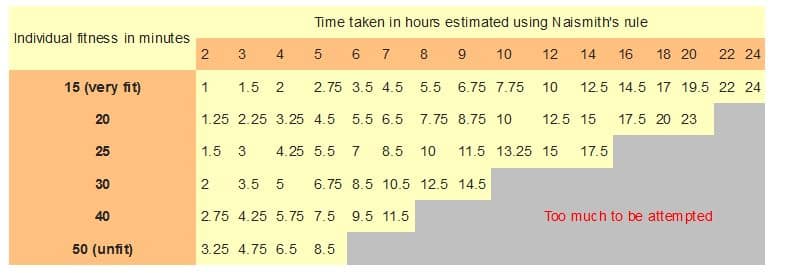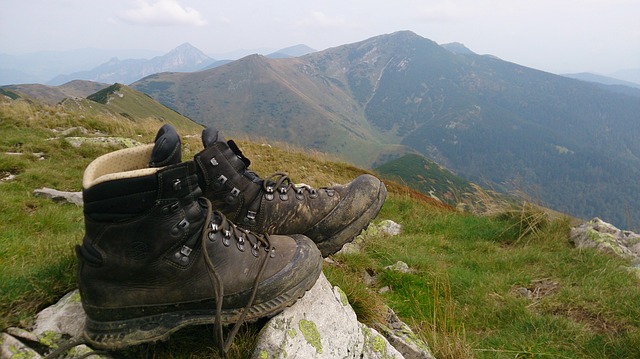When I first started going hiking and backpacking, I was really bad at calculating how long the hike would take. Once, this resulted in my group arriving at base camp after nightfall. We were lucky that no one sprained their ankles while walking in the dark. Now I’ve learned my lesson and always use this formula to calculate how long a hike will take.
Quick Answer:
If you are fairly fit and the conditions are mild (no snow, ice, or slick mud), expect it to take 20 minutes for each mile plus 60 minutes for every 2,000 feet of ascent. If you are hiking with a heavy pack, then calculate 30 minutes for each mile plus 60 minutes for every 1,000 feet of ascent. Don’t forget to add time for breaks into these calculations.
Important: Hikes can take longer than you expect, or injuries can happen, causing you to spend an unplanned night in the wilderness. That’s why you must always bring these emergency items hiking.
Naismith’s Rule
Naismith’s Rule was devised by a Swedish hiker in the 1890s to calculate how long a hike would take. Even though some hikers have come up with their own modifications to the rule, it is still one of the most common guidelines used to calculate how long a hike will take. Note that the rule is made assuming that you will be hiking on a trail or footpath of some kind, and the hike will be of moderate difficulty.
The rule is as follows:
Allow 20 minutes for every 1 mile forward PLUS 60 minutes for every 2000 feet of ascent
For example, the Phelps Lake trail in the Grand Tetons is 4.7 miles and has an elevation gain of 965 feet. Based on the Naismith rule, you would calculate that it would take 123 minutes to complete. Here’s how the math looks like:
(20 minutes x 4.7 miles) + (965ft/2000ft) x 60 minutes = 123 minutes
Adjustments for Fitness Level, Conditions, and Duration
There are a lot of situations where Naismith’s rule doesn’t hold up. Your fitness level obviously comes into play. The hiking conditions — such as if the trails are clear, snowy, icy, or slick — will affect how long it takes. There’s also the issue that hikers tend to slow down over time due to fatigue: you’ll hike faster in the first hour than you will in the 5th and so forth.
“Tranter’s Corrections” is a method of calculating for these factors. It is based on Naismith’s Rule but adjusts accordingly.
Here’s how it works:
- First calculate using Naismith’s rule.
- Then look at the chart below.
- Find how long Naismith’s rule said it would take in the top row of numbers and the adjustment according to your fitness level.
- You can also adjust based on terrain or weather. If conditions are tough, then drop a fitness level. For very tough conditions, drop multiple fitness levels.
 *Fitness level is determined by how long it takes you to climb 1000 feet over 1/2 mile.
*Fitness level is determined by how long it takes you to climb 1000 feet over 1/2 mile.
For example:
If Naismith’s rule calculated it would take you 3 hours to complete a hike and you are insanely fit, then you could adjust that it would only take you 1.5 hours. By contrast, if you were very unfit (or the conditions are going to be terrible), you’d adjust to 4.75 hours.
Don’t Forget to Factor in Breaks!
Naismith’s Rule does NOT include time for breaks. When I’m hiking with adults, we generally will stop every 20 to 30 minutes. When I’m hiking with my kids, we make a break every 10 minutes or so.
Hiking Time with a Full Backpack
Naismith’s Rule is for day hikes. It isn’t meant to be used for backpacking through the woods to your base camp. Obviously, it is going to take you a LOT longer to walk when you’ve got a huge pack on your back.
With backpacking gear and on moderate terrain, use this formula:
Allow 30 minutes for every 1 mile forward PLUS 60 minutes for every 1000 feet of ascent
Adjusting for Hikes with Children
Last summer I went hiking with my daughter who is 5 years old. The hike was 2.3 miles and had an elevation gain of 1,200 feet. Based on Naismith’s Rule, it should have taken us about 1 hour 20 minutes. It took us over 2 ½ hours! That’s why the second part of Naismith’s Rule is “calculate speed based on the slowest person.”
If you want to take your small kids hiking, go for it. But I’d recommend doubling the time it would probably take you. Even then, you’ve got to be prepared to turn around and not make it to the destination. Or, if you are backpacking towards base camp, be prepared to set up camp wherever you can reach.
Also read: how far can kids hike?
Not sure what to eat while outdoors? I’ve just written an eBook with over 50 dehydrator trail recipes, plus tons of advice on meal planning for backpacking trips.
Learn more here.

These are the types of meals I’m eating when I backpack. They pack in over 130 calories per ounce dry weight. Just add water to rehydrate!

This is what the meals look like dehydrated. This picture shows 13,700 calories of food and only weigh 6.9lbs dry. Just add water to rehydrate!
Ready to step up your trail food? Buy my eBook here. 🙂













3 Comments
Lila
October 19, 2021 at 3:31 pmI am going to be hiking on a road and it is going to be about maybe 6.8 miles and i am going to have some 6 to 8 years old so I not sure how long it will take and there isn’t much elevation rise.
Diane
October 19, 2021 at 7:17 pmIt really varies depending on the kid. My girl went insanely SLOOOOWWWW at 6 years old and often had to be bribed to hike further. She’d also ask for breaks constantly. It will go a lot faster if you plan some ways to motivate them — like telling them that they get a candy when they reach point X or turn it into some sort of race/game.
Rosemary Huebner
August 20, 2023 at 6:27 pmYes, candy is a super motivator. Some climbing rocks along the way do add to the fun of hiking!